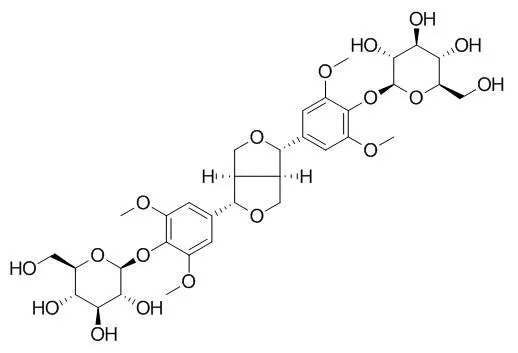| Description: |
Liriodendrin has anti-inflammatory, antinociceptive, hypoglycemic activities, it plays protective role in sepsis-induced acute lung injury, it regulates lung inflammation, the phosphorylation of the NF-kB (p65) and expression of vascular endothelial growth factor (VEGF). Liriodendrin has protective effects on dopamine-induced cytotoxicity via its anti-oxidative properties by reducing ROS level and anti-apoptotic effect via protection of mitochondrion membrane potential (ΔΨm). It may be a potent suppressor of CaCl(2)-induced arrhythmias, the prophylactic administration of liriodendrin is effective in prolonging latency of arrhythmia and reducing the occurrence of ventricular fibrillation from 75% to 25%. Liriodendrin has inhibitory activities on gastritis and gastric ulcer, it can inhibit colonization of Helicobacter pylori effectively, it could be utilized for the treatment and/or protection of gastritis and gastric ulcer.
|
| Targets: |
PGE | ATPase | Potassium Channel | NO | TNF-α | NOS | COX | ROS | p53 | VEGFR | p65 | NF-kB |
| In vitro: |
| Arch Pharm Res. 1999 Feb;22(1):30-4. | | Metabolism of liriodendrin and syringin by human intestinal bacteria and their relation to in vitro cytotoxicity.[Pubmed: 10071956] |
METHODS AND RESULTS:
When Liriodendrin or syringin was incubated for 24 h with human intestinal bacteria, two metabolites, (+)-syringaresinol-beta-D-glucopyranoside and (+)-syringaresinol, from Liriodendrin and one metabolite, synapyl alcohol, from syringin were produced. The metabolic time course of Liriodendrin was as follows: at early time, Liriodendrin was converted to (+)-syringaresinol-beta-D-glucopyranoside, and then (+)-syringaresinol.
CONCLUSIONS:
The in vitro cytotoxicities of these metabolites, (+)-syringaresinol and synapyl alcohol, were superior to those of Liriodendrin and syringin. |
|
| In vivo: |
| Biomol Ther (Seoul). 2015 Jan;23(1):53-9. | | Protective Effect of Liriodendrin Isolated from Kalopanax pictus against Gastric Injury.[Pubmed: 25593644] | In this study, we investigated the inhibitory activities on gastritis and gastric ulcer using Liriodendrin which is a constituent isolated from Kalopanax pictus.
METHODS AND RESULTS:
To elucidate its abilities to prevent gastric injury, we measured the quantity of prostaglandin E2 (PGE2) as the protective factor, and we assessed inhibition of activities related to excessive gastric acid be notorious for aggressive factor and inhibition of Helicobacter pylori (H. pylori) colonization known as a cause of chronic gastritis, gastric ulcer, and gastric cancer. Liriodendrin exhibited higher PGE2 level than rebamipide used as a positive control group at the dose of 500 μM. It was also exhibited acid-neutralizing capacity (10.3%) and H(+)/K(+)-ATPase inhibition of 42.6% (500 μM). In pylorus-ligated rats, Liriodendrin showed lower volume of gastric juice (4.38 ± 2.14 ml), slightly higher pH (1.53 ± 0.41), and smaller total acid output (0.47 ± 0.3 mEq/4 hrs) than the control group. Furthermore Liriodendrin inhibited colonization of H. pylori effectively. In vivo test, Liriodendrin significantly inhibited both of HCl/EtOH-induced gastritis (46.9 %) and indomethacin-induced gastric ulcer (46.1%).
CONCLUSIONS:
From these results, we suggest that Liriodendrin could be utilized for the treatment and/or protection of gastritis and gastric ulcer. | | Arch Pharm Res. 2010 Dec;33(12):1927-32. | | A new triterpene and an antiarrhythmic liriodendrin from Pittosporum brevicalyx.[Pubmed: 21191756] | A new triterpene, 21-O-senecioyl-R(1)-barrigenol (1) and 13 known compounds were isolated from the ethanol extracts of the leaves and bark of Pittosporum brevicalyx (Oliv.) Gagnep.
METHODS AND RESULTS:
Their structures were elucidated based on spectral data. The antiarrhythmic action of one furofuran lignan, Liriodendrin (2), was tested on a model of CaCl(2)-induced arrhythmia and compared with the effect of verapamil. The prophylactic administration of Liriodendrin (2) was effective in prolonging latency of arrhythmia and reducing the occurrence of ventricular fibrillation from 75% to 25%. The overall mortality rate was significantly reduced by the prophylactic administration of Liriodendrin from 87.5% to 25%. The antiarrhythmic effect of Liriodendrin (5.0 mg/kg) was similar to that of verapamil (1.05 mg/kg).
CONCLUSIONS:
Thus, Liriodendrin may be a potent suppressor of CaCl(2)-induced arrhythmias. | | Medical Journal of Wuhan University, 2008, 29(6):759-62. | | Hypoglycemic Effects of Active Constituents Extracted from the Stem Bark of Kalopanax Septemlobus(Thunb.)Koidz.in Guangxi.[Reference: WebLink] | To study the hypoglycemic active fractions or constituents that were extracted and isolated from the stem bark of Kalopanax septemlobus(Thunb.) Koidz.in Guangxi.
METHODS AND RESULTS:
Three fractions were obtained by extracting with alcohol,separating systematically and isolating by the silica and macroporous resin chromatography methods.The hypoglycemic activity of the constituents from the three fractions respectively was evaluated using diabetic models induced by alloxanin in mice.Then the effective fraction was separated by pharmacodynamic test and the monomer components were identified from the effective fraction. Three monomer components,Liriodendrin(Ⅰ),Kalopanax saponine B(Ⅱ) and Kalopanax saponine H(Ⅲ),were obtained from the only effective fraction of all the three fractions.
CONCLUSIONS:
Liriodendrin(Ⅰ) is thought to be found firstly in this plant,and the fraction extracted from Kalopanax septemlobus(Thunb.) Koidz.in Guangxi showes an excellent hypoglycemic activity. |
|






 Cell. 2018 Jan 11;172(1-2):249-261.e12. doi: 10.1016/j.cell.2017.12.019.IF=36.216(2019)
Cell. 2018 Jan 11;172(1-2):249-261.e12. doi: 10.1016/j.cell.2017.12.019.IF=36.216(2019) Cell Metab. 2020 Mar 3;31(3):534-548.e5. doi: 10.1016/j.cmet.2020.01.002.IF=22.415(2019)
Cell Metab. 2020 Mar 3;31(3):534-548.e5. doi: 10.1016/j.cmet.2020.01.002.IF=22.415(2019) Mol Cell. 2017 Nov 16;68(4):673-685.e6. doi: 10.1016/j.molcel.2017.10.022.IF=14.548(2019)
Mol Cell. 2017 Nov 16;68(4):673-685.e6. doi: 10.1016/j.molcel.2017.10.022.IF=14.548(2019)